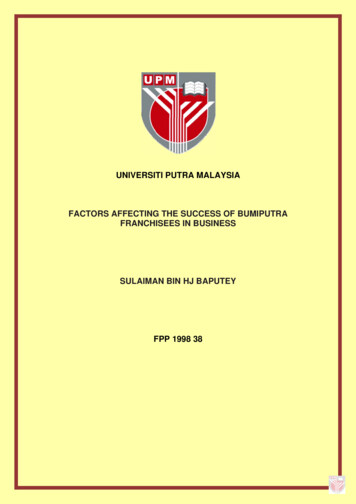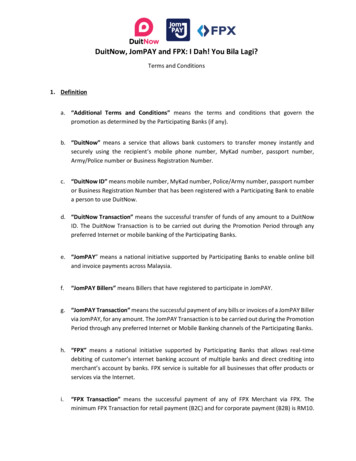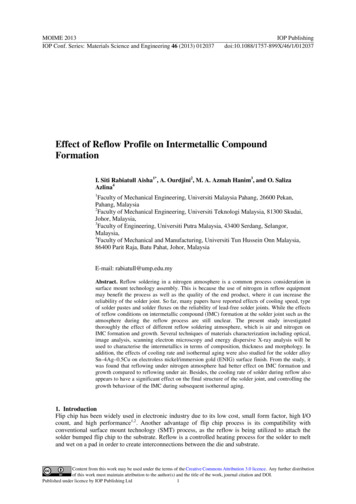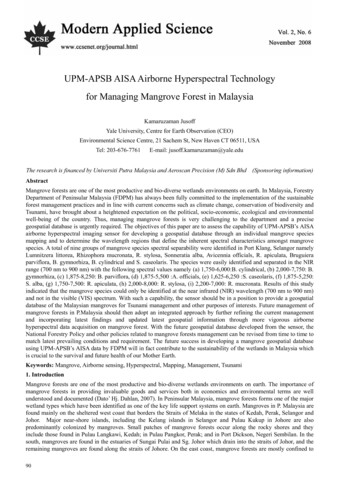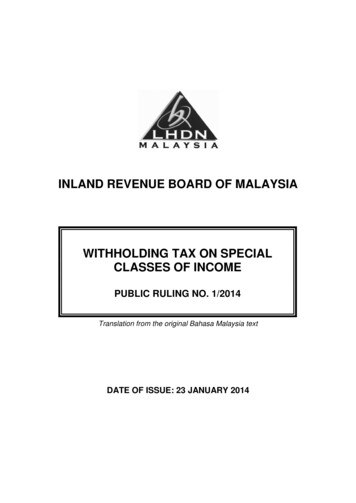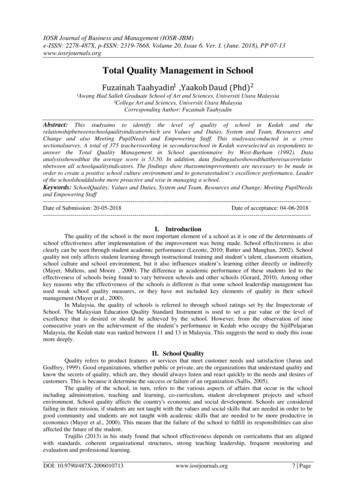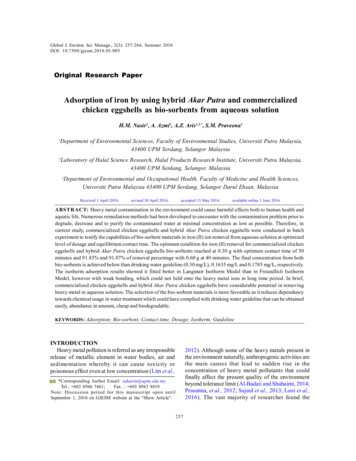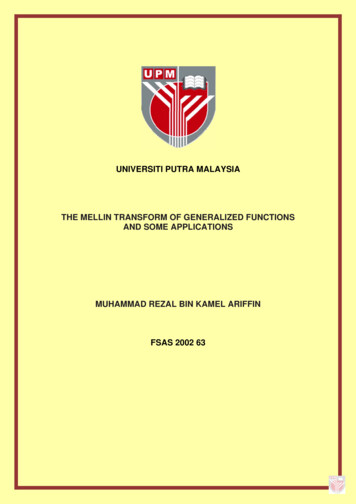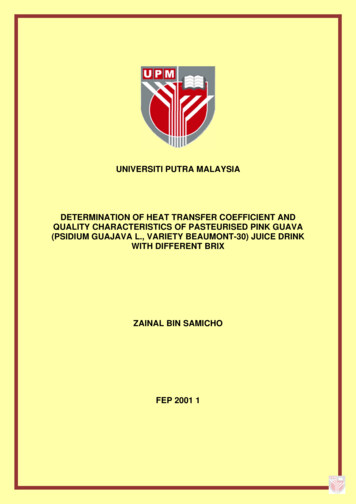
Transcription
UNIVERSITI PUTRA MALAYSIADETERMINATION OF HEAT TRANSFER COEFFICIENT ANDQUALITY CHARACTERISTICS OF PASTEURISED PINK GUAVA(PSIDIUM GUAJAVA L., VARIETY BEAUMONT-30) JUICE DRINKWITH DIFFERENT BRIXZAINAL BIN SAMICHOFEP 2001 1
DETERMINATION OF BEAT TRANSFER COEmCIENT AND QUALITYCHARACTERISTICS OF PASTEURISED PINK GUAVA (PSIDIUMGUAJAVA L., VARIETY BEAUMONT-30) JUICE DRINK WITH DIFFERENTBRIXByZAINAL BIN SAMICHOThesis Submitted in Fulfilment of the Requirements for the Degree ofDoctor of Philosophy in the Faculty orFood Science and BiotechnologyUniversiti Putra MalaysiaSeptember 2001
Abstract of the thesis presented to the Senate ofUniversiti Putra Malaysia infulfilment of the requirements for the degree of Doctor of PhilosophyDETERMINATION OF HEAT TRANSFER COEFFICIENT ANDQUALITY CHARACTERISTICS OF PASTEURISED PINK GUAVA(PSIDIUM GUAJAVA L., VARIETY BEAUMONT-30) JUICE DRINKWITH DIFFERENT BRIXByZAINAL BIN SAMICHOSeptember 2001Chairman: Associate Professor Dr. Russly Abd. RahmanFaculty: Food Science and BiotechnologyinHeat transfer plays a key rolethe production of good qualitypasteurised fruit juice drink Knowledge of heat transfer during the pasteurisation.process and the necessity of analysing the data quantitatively have becomeincreasingly important in modem pasteurisation technology. The importance ofheat transfer in the production of comfort heating was readily apparent. Heattransfer was not only important in designing the pasteurisation equipment but itwas also important in the optimisation of the pasteurisation process for theproduction of high quality fruit juicedrink.Several properties of fruit juicedrinksuch as the microbial, enzyme and sucrose contents, cloud stability and ascorbicacid are greatly affected by heat transfer during pasteurisation.The effect of various operating conditions of pasteurisation on thethennophysical properties (density, thennal conductivity, specific heat capacity,2
consistency coefficient and flow behaviour index) of pink guava juice drink wasinvestigated. Pink guava juice drink with different total soluble solids (90srixand 1 1 0srix) at pH 3.7 with an average particle size ofO.3SS rnm was used inthis study. The pink guava (Psidium guajava L.) variety Beaumont: B-30 wassupplied by the Golden Hope Plantation, Kulai, lohore, Malaysia. Allpasteurisation experiments were perfonned by using a pilot plant heat exchanger(APV tubular pasteuriser), which was operated at different temperatures andmass flow rates or holding times. During storage at S oC and at room temperature,the quality of the juice drink pasteurised at different conditions, measured aspectinesterase activity, cloud stability, microbial population, sugar and ascorbicacid contents, was analysed.The data gathered from this study were used to develop models whichcould be employed to describe the variation in the physical properties of pinkguava juice drink with different total soluble solids as a flmction of thepasteurisation operating temperature. The heat transfer coefficient models whichrelated to mass flow rate for laminar flow were also developed. Such models areuseful for the simulation process, so that the rate of heat transfer to the juicedrink and the quality of the pasteurised juice drink at different pasteurisationoperating conditions could be predicted. The models could also be used indesigning the pasteurisation set up and the optimisation of the pasteurisationprocess with a great reduction in the number of experimental runs to be carriedout.3
Abstrak tesis yang dikemukakan kepada Senat Universiti Putra Malaysia sebagaimemenuhi keperluan Wltuk Ijazah Doktor FalsafahPENENTUAN ANGKALI PEMINDAHAN HABA DAN CIRI CIRIKUALITI TERPASTEUR JUS MINUMAN JAMBU MERAB (PSIDIUMGUAJAVA L., JENIS BEAUMONT-30) YANG BERBEZA BRIX-OlehZAINAL BIN SAMICHOSeptember 2001Pengerusi: Professor Madya Dr. Russly Abdul RahmanFakulti: Sains Makanan dan BioteknologiPemindahan haba memainkan peranan penting dalam penghasilan jusminuman buah-buahan terpasteur yang berkualiti baik. Pengetahuan berkaitandengan pemindahan haba semasa proses pempasteuran dan keperluanmenganalisis data secara kuantitatif menjadi bertambah penting dalam teknologipempasteuran moden. Kepentingan pemindahan haba dalam membantu prosespemanasan telah tersedia maklum. Pemindahan haba bukan sahaja penting dalammerekabentuk peralatan pempasteuran tetapi juga Wltuk mendapatkan prosespempasteuran yang optimis bagi tujuan menghasilkan jus minuman buah-buahanyang berkualiti tinggi. Beberapa ciri jus minuman buah-buahan sepertikandWlgan mikrob, enzim dan sukrosa, kestabilan keruh dan asid askorbik amatmudah dipengaruhi oleh pemindahan haba semasa pempasteuran.4
Kajian berkaitan dengan kesan daripada pelbagai keadaan pempasteuranterhadap ciri-ciri fizikal haba (ketumpatan, keberaliran haba, muatan haba tentu,pekali kekonsistenan dan indek kelakuan aliran) jus minuman jambu meIah telahdilakukan. Jus minuman jambu merah yang berlainan jumlah pepejal larot(9earix dan I Iearix), pH 3.7 dan majoriti saiz zarah 0.355 mm, telah digunakandalam kajianini.Jambu merah (Psidium guajava L.) jenis Beaumont: B-30didapati dari Estet Golden Hope, Kulai, Johor, Malaysia. Kesemua ujikajipempasteuran dijalankan dengan menggunakan loji pandu penukar haba (alatpempasteuran tiub APV) yang beroperasi pada suhu dan kadar aliran jisim yangberlainan atau masa menahan. Semasa penstoran pada 5 C dan suhu bilik, kualitijus minuman yang dipasteurkan pada keadaan berlainan telah dianalisis dari segiaktiviti enzim pectinesterase, kestabilan keruh, populasi mikrob, kandungan guladan kandungan asid askorbik.Himpunan data daripada kajian ini telah digunakan untuk menghasilkanmodel-model yang boleh menerangkan perubahan ciri-ciri fizikal jus minumanjambu merah berlainan jumlah pepejal larut sebagai fungsi suhu operasipempasteuran. Model-model pekali pemindahan haba berkaitan dengan kadaraliran jisim bagi aliran lamina telah dapat dihasilkan juga. Model-model tersebutamat berguna untuk perlakuan proses dan dengan itu kadar pemindahan habakepada jus minuman dan kualiti jus minuman pasteur pada keadaan operasipempasteuran yang berbeza boleh diramalkan. Model-model tersebut juga bolehdigunakan untuk merekabentuk alat pempasteuran yang hendak dicipta juga5
dapat menghasilkan satu kaedah yang lebih optimis dalam proses pempastemandan dengan itu boleh mengmangkan banyak ujikaji cubaan.6
ACKNOWLEDGEMENTSIn the name of Allah, the Most Beneficient, the Most MercifulI thank Associate Professor Dr. Russly Abdul Rahman, AssociateProfessor Dr. Arbakariya Ariff and Associate Professor Dr. Nazamid Saari fortheir encouragement and patience in supervising this work.I am grateful to the Faculty of Food Science and Biotechnology forpermission to use all of the facilities which made my project successful andmeaningful.I am indebted to Universiti TeknologiMARA,Selangor, Malaysia forproviding the scholarship which made my Ph.D programme in Universiti PutraMalaysia possible.I am deeply grateful to my late father, to my mother and to my family fortheir constant encouragement, advice and moral support.And last, but not least, I would like to extend my thanks to everyone whohas directly or indirectly, contributed towards the completion of this thesis suchas Associate Professor Dr. Sa1mah Yusuf, Mr. Dzulkifli Mat Hashim, Mr.Mustafa Marzuki,Mr.Amran Suratman, Mr. Azhar Mohd. Noor, Mr. RazaliOthman, Mr. RusH Aslim and others.7
I certify thatan Examination Committee met on7th September 2001 to conductthe final examination of Zainal bin Samicho on his Doctor of Philosophy thesisentitled "Determination of Heat Transfer Coefficient and Quality Characteristicsof Pasteurised Pink Guava(Psidium Guajava L.,Variety Beaumont-30) JuiceDrink with Different Brix" in accordance with Universiti Pertanian Malaysia(Higher Degree) Act 1980 and Universiti Pertanian Malaysia (Higher Degree)Regulations 1981. The Committee recommends that the candidate be awardedthe relevant degree.Members of the Examination Committee are as follows:Gulam Rusul Rahmat Ali, Ph.D.Professor,Faculty of Food Science and BiotechnologyUniversiti Putra Malaysia(Chairman)Russly Abd. Rahman, Ph.D.Associate ProfessorFaculty of Food Science and BiotechnologyUniversiti Putra Malaysia(Member)Arbakariya Ariff, Ph.D.Associate ProfessorFaculty of Food Science and BiotechnologyUniversiti Putra Malaysia(Member)Nazamid Saari, Ph.D.Associate ProfessorFaculty of Food Science and BiotechnologyUniversiti Putra Malaysia(Member)Romeo Toledo, Ph.D.ProfessorDepartment of Food Science and TechnologyUniversity of GeorgiaAthens, U.S.A.(Independent Examiner)MO SHAYlDIN.Ph.Do.Professorl Deputy Dean of Graduate School,Universiti Putra MalaysiaDate:3 0 OCT 20018
This thesis submitted to Senate ofUniversiti Putra Malaysia has been acceptedas fulfilment of the requirement for the degree of Doctor of Philosophy.AINI IDERIS, Ph. D.Professor,Dean of Graduate School,Universiti Putra MalaysiaDate: 1 3 DEC 20019
I hereby declare that the thesis is based on my original work except forquotations and citations, which have been duly acknowledged. I also declare thatit has not been previously or currently submitted for any other degree at UPM orother institutions.Date: q10/10/.;2.(901
TABLE OF AL SIIEETS . . . . . . . . . . . . . . . . . . . . . . . . . . . . . . . . . . . . . . . . . . . . . . . . . . . . . . . . . . .DECLARATION FORM . . . . . . . . . . . . . . . . . . . . . . . . . . . . . . . . . . . . . . . . . . . . . . . . . . . . . . . .LIST OF TABLES . . . . . . . . . . . . . . . . . . . . . . . . . . . . . . . . . . . . . . . . . . . . . . . . . . . . . . . . . . . . . . . . .LIST OF FIGURES . . . . . . . . . . . . . . . . . . . . . . . . . . . . . . . . . . . . . . . . . . . . . . . . . . . . . . . . . . . . . . .LIST OF PLATES . . . . . . . . . . . . . . . . . . . . . . . . . . . . . . . . . . . . . . . . . . . . . . . . . . . . . . . . . . . . . . . .LIST OF ABBREVIATIONS . . . . . . . . . . . . . . . . . . . . . . . . . . . . . . . . . . . . . . . . . . . . . . . . . . . .24781016192123CHAPTER. . . . . 27IGENERAL INTRODUCTIONIILITERATURE REVIEW . . . . . . . . . . . . . . . . . . . . . . . . . . . . . . . . . . . . . . . . . . . . .Guava . . . . . . . . . . . . . . . . . . . . . . . . . . . . . . . . . . . . . . . . . . . . . . . . . . . . . . . . . . . . . . . . . . . . . . . . . .Biochemical Compositions of Guava. .Pectinesterase . . . . . . . . . . . . . . . . . . . . . . . . . . . . . . . . . . . . . . . . . . . . . . . . . . . . . . . . . . . . . .Mechanism for Pectinesterase Activity . . . . . . . . . . . . . . . . . . . . . . . . . . .Optimum pH for Pectinesterase Activity . . . . . . . . . . . . . . . . . . . . . . .Optimum pH and Temperature for PectinesteraseActiVIty . . . . . . . . . . . . . . . . . . . . . . . . . . . . . . . . . . . . . . . . . . . . . . . . . . . . . . . . . . .Importance of Pectinesterase on Cloud Stability.Fruit Juice Cloud . . . . . . . . . . . . . . . . . . . . . . . . . . . . . . . . . . . . . . . . . . . . . . . . . . . . . . . . . . .Clarification of Juice . . . . . . . . . . . . . . . . . . . . . . . . . . . . . . . . . . . . . . . . . . . . . . . .Stabilisation of Cloud Juice . . . . . . . . . . . . . . . . . . . . . . . . . . . . . . . . . . . .Heat Treatment . . . . . . . . . . . . . . . . . . . . . . . . . . . . . . . . . . . . . . . . . . . . . . . . . . . . . . . . . . . . . .Pasteurisation . . . . . . . . . . . . . . . . . . . . . . . . . . . . . . . . . . . . . . . . . . . . . . . . . . . .Thermostability of Pectinesterase . . . . . . . . . . . . . . . . . . . . . . . . . . . . .Effect of Heating. . . . . . . . .Vitamin . . . . . . . . . . . . . . . . . . . . . . . . . . . . . . . . . . . . . . . . . . . . . . . . . . . . . . . .Physical and Chemical Changes . . . . . . . . . . . . . . . . . . . . . . . . . . . . . . . .Colour and FlavourRheological Properties of Fluid Foods . . . . . . . . . . . . . . . . . . . . . . . . . . . . . . . . .Classification of Fluid Foods. . . . . . . . . . . . . . . . . . . . . .Rheological Models for Viscous Foods. .Models for Time-Independent Behaviour . . . . . . . . . . . . . . . . . . . .Measurement of Flow Properties of Fluid Foods . . . . . . . . . . . . . . . . . . . . .Rheology of Fluid and Food Processing . . . . . . . . . . . . . . . . . . . . . . . . . . . .11. . .333334343739414244474955555962626364656568687071
Heat Transfer . . . . . . . . . . . . . . . . . . . . . . . . . . . . . . . . . . . . . . . . . . . . . . . . . . . . . . . . . . . . . . .Heat Transfer to Foods Flowing in Tubes . . . . . . . . . . . . .Heat transfer to Pseudoplastic Fluid in Laminar Flow.Tubular Heat Exchanger . . . . . . . . . . . . . . . . . . . . . . . . . . . . . . . . . . . . . . . . . . . . . . . . . . .Application of Tubular Heat Exchanger . . . . . . . . . . . . . . . . . . . . . . .Storage Stability of Fruit Juice Drink . . . . . . . . . . . . . . . . . . . . . . . . . . . . . . . . . .CloOO I.,ossMicrobial Spoilage . . . . . . . . . . . . . . . . . . . . . . . . . . . . . . . . . . . . . . . . . . . . . . . . . . .Sugar Fermentation. . . . . . . . . . . . . . . . . . . . . . .Ascorbic Acid Degradation . . . . . . . . . . . . . . . . . . . . . . . . . . . . . . . . . . . . . . . . . . .mTHERMOPHYSICAL PROPERTIES OF PSEUDOPLASTICCHARACI'ERISTICS OF PINK GUAVA JUICE DRINKAT TWO LEVELS OF'TOTAL SOLUBLE SOLIDS . . . . . . . . . . . . . . . . . . . . . . . . . . . . . . . . . . . . . . . . . . . . . . . . . . . . . . . . . . . . . . .IntroductionMaterials and Methods. . . . . . . . . . . . . . . . . . . . . . . . . . . . . . . . . . . . . . . . . . . . . . . . . .Materials . . . . . . . . . . . . . . . . . . . . . . . . . . . . . . . . . . . . . . . . . . . . . . . . . . . . . . . . . . . . . . . .Sample PreparationPseudoplastic Characteristic: Flow Behaviour Index andConsistency Coefficient . . . . . . . . . . . . . . . . . . . . . . . . . . . . . . . . . . . . . . . . . . . . . . . .DensityThetlD.al Conductivity.Specific Heat Capacity. . . . . . . . . . . . . . . . . . . . . . . . . . . . . . . . . . . . . . . . . .andDiscussions. . . . . . . . . . . . . . . . . . . . . . . . . . . . . . . . . . . . . . . .ResultsEffect of Temperature and Total Soluble Solids onPseudoplastic Characteristic, Flow Behaviour Index. . . . . . .and Consistency CoefficientEffect of Temperature and Total Soluble Solids on Density. . .Effect of Temperature and Total Soluble Solids on ThermalConductivity . . . . . . . . . . . . . . . . . . . . . . . . . . . . . . . . . . . . . . . . . . . . . . . . . . . .Effect of Temperature and Total Soluble Solids on.Specific Heat CapacityConclusion . . . . . . . . . . . . . . . . . . . . . . . . . . . . . . . . . . . . . . . . . . . . . . . . . . . . . . . . . . . . . . . . . . . . . . . . . . . . . . . . . . . . . . . . . . . . . .IV. . . .LAMINAR HEAT TRANSFER TO PINKGUAVA JUICE DRINK EXHIBITED PSEUDOPLASTICBEHAVIOURINTUBULAR HEAT EXCHANGER. . . . . . . . . . . . . . . . . . . . . . . . . . . . . . . . . . . . . . . . . . . . . . . . . . . . . . . . . . . . . . .Introduction. . . . . . . . . . . . . . . . . . . . . . . . . . . . . . . . . . . . . . . . . . . . . . . . . . . . .Mass balanceHeat transfer . . . . . . . . . . . . . . . . . . . . . . . . . . . . . . . . . . . . . . . . . . . . . . . . . . . . . . . .Materials and Methods . . . . . . . . . . . . . . . . . . . . . . . . . . . . . . . . . . . . . . . . . . . . . . . . . . . . .Materials . . . . . . . . . . . . . . . . . . . . . . . . . . . . . . . . . . . . . . . . . . . . . . . . . . . . . . . . . . . . . . . . . . . . . . . . . . . . .Sample PreparationSpecific Heat Capacity. . . . .Density. . . . . . . . . . . . . . . . . . . . . . . . . . . .12717173767879808082838585868687888989909090981 001021 041051 051 061 091111111111 121 12
Viscosity, Flow Behaviour Index andConsistency Coefficient.Heat Treatment of Juice Drink . . . . . . . . . . . . .Results and Discussion . .Shear Rate. . . . . .Characteristic of Juice Drink.Heat TransferConclusion.VRELATIVE RESIDUE PECI'INESTERASE ACI'IVITYAND CLOUD LOSS OF PINK GUAVA JUICE DRINKPASTEURISED AT DIFFERENT BEAT QUANTITYIntroduction.Materials and MethodsMaterials.Sample PreparationHeat Treatment of Juice Drink . . . .Determination of Pulp ContentDetermination ofPE Activity . .Cloud Index Determination . .Calcium Determination .Statistical Analysis. . .Results and Discussion . . . .Effect of Pasteurisation Conditions on PE Activity.Effect ofTSS on PE Activity . .Effect of Storage T.emperature on PE ActivityEffect of Pulp Content on PE Activity.Effect of Pasteurisation Conditions on Cloud Loss .Effect ofTSS on Cloud Loss .Effect of Storage Temperature on Cloud Loss . .Effect of Pulp Content on Cloud LossEffect of Calcium Content on Cloud Loss. . .Relationship Between PE Activity and Cloud Loss .Conclusion . . . . . .1251251281281281281291301301311321321321361 37138138141142142143144147EEFECf OF DIFFERENT BEAT QUANTITY ONMICROORGANISM POPULATION, SUGAR ANDASCORBIC ACID CONTENT INPINK GUAVAJUICE DRINK DURING STORAGE. . . . .Introduction. . . .Materials and MethodsMaterials. .Sample PreparationHeat Treatment of Juice Drink. . . . . . . . . .Microbiological Analysis . . . . . . . . . . . . . .Determination of Sugar1481481 531 531 531531 541 55. . . . . . . . . .VI1 121 131 161 161 17120124.13. . .
Preparation of Sample for HPLC . . . . . . . . . . . . . . . . . . . . . . . . . . . . . . . .Preparation of Standard . . . . . . . . . . . . . . . . . . . . . . . . . . . . . . . . . . . . . . . . . .Quantification of Sugar . . . . . . . . . . . . . . . . . . . . . . . . . . . . . . . . . . . . . . . . . . . .Detennination of Ascorbic Acid . . . . . . . . . . . . . . . . . . . . . . . . . . . . . . . .Statistical Analysis . . . . . . . . . . . . . . . . . . . . . . . . . . . . . . . . . . . . . . . . . . . . . . . .Results and Discussions . . . . . . . . . . . . . . . . . . . . . . . . . . . . . . . . . . . . . . . . . . . . . . . . . . . .Mesophilic . . . . . . . . . . . . . . . . . . . . . . . . . . . . . . . . . . . . . . . . . . . . . . . . . . . . . . . . . .Yeast and Mould . . . . . . . . . . . . . . . . . . . . . . . . . . . . . . . . . . . . . . . . . . . . . . . . . .Lactic acid bacteria . . . . . . . . . . . . . . . . . . . . . . . . . . . . . . . . . . . . . . . . . . . . . . . .156156156157158158158161164Properties Affecting Sucrose Concentration DuringStorage of Pasteurised Pink Guava Juice Drink . . . . . . . . . . . . . . . .Effect of Heat Quantity on Sucrose . . . . . . . . . . . . . . . . . . . . . .Effect of Total Soluble Solids on Sucrose . . . . . . . . . . . . . . . .Effect of Storage Temperature on Sucrose . . . . . . . . . . . . .169170170173Properties Affecting Glucose Concentration DuringStorage of Pasteurised Pink Guava Juice Drink .Effect of Heat Quantity on Glucose . . . . . . . . . . . . . . . . . . . . .Effect of Total Soluble Solids on Glucose . . . . . . . . . . . . . . .Effect of Storage Temperature on Glucose . . . . . . . . . . . . . .1 731 761761 77Properties Affecting Fructose Concentration DuringStorage of Pasteurised Pink Guava Juice Drink . . . . . . . . . . . . . . . .Effect of Heat Quantity on Fructose . . . . . . . . . . . . . . . . . . . . . .Effect of Total Soluble Solids on Fructose . . . . . . . . . . . . . . .Effect of Storage Temperature on Fructose . . . . . . . . . . . .Effect of Heat Quantity on Ascorbic Acid . . . . . . . . . . . . . . .Effect of Total Soluble Solids on Ascorbic Acid . . . . . .Effect of Storage Temperature on Ascorbic Acid . . . . . . .ConclusionVIICONCLUSION AND RECOMMENDATIONFOR FUTURE WORK . .BIBLIOGRAPHYAPPENDICES. . . . . . . . . . . . . . . . . . . .BIOGRAPmCAL SKETCH. . .14. . .1771781 78181182185186186190193205230
APPENDICESPageAppendix A: Total Hectarage of Guava in Peninsular Malaysia.205Appendix B: Chemical Composition of Fruit Juices . . . . . . . . . . . . . . . . . . . . . . . . . . .206Appendix C: Types and Characteristics of Guava . . . . . . . . . . . . . . . . . . . . . . . . . . . . . . .207Appendix D: Nutrient Composition of Guava . . . . . . . . . . . . . . . . . . . . . . . . . . . . . . . . . . . .21 1Appendix E: Characteristics of Guavas for Juice Processing . . . . . . . . . . . . . . . . . .212Appendix F: Amount and Value of Guava Exported214. . . . .Appendix G: Malaysia'S 1991 Export and Total Value for Freshand Processed Fruits . . . . . . . . . . . . . . . . . . . . . . . . . . . . . . . . . . . . . . . . . . . . . . . .215Appendix H: Biochemical Changes in Guava (cv Baladia)During Ripening . . . . . . . . . . . . . . . . . . . . . . . . . . . . . . . . . . . . . . . . . . . . . . . . . . . . . .216Appendix I : Plates217.Appendix J: Standard Curve for Sugar . . . . . . . . . . . . . . . . . . . . . . . . . . . . . . . . . . . . . . . . . . .15229
LIST OF TABLESTablePage1: The Presence of Pectinesterase in Some Fruits . . . . . . . . . . . . . . . . . . . . . . . . . 352: Distribution ofPectinolytic Enzymes in Some Microorganisms . . . . . . . . . 353: The Optimum pH for Pectinesterase Activity in SomeMicroorganisms and Fruits . . . . . . . . . . . . . . . . . . . . . . . . . . . . . . . . . . . . . . . . . . . . . . . .404: Optimum pH and Temperature of Some Fruits andMicrobial Pectinesterase . . . . . . . . . . . . . . . . . . . . . . . . . . . . . . . . . . . . . . . . . . . . . . . . . . . .42.5: Composition of Orange Juice Cloud . . . . . . . . . . . . . . . . . . . . . . . . . . . . . . . . . . . . . . . 476: Effect of Heat Treatment on the Cloud Retention in Shamuti (Jaffa)Orange Juice.507: Influence of Calcium Ions and pH on the Retention of Cloud ParticlesSubjected to PE Action in Shamuti(Jaffa) Orange Juice . . . . . . . . . . . . . . . . . .518: Pectinesterase (In)activators and Inhibitors. . .529: Effect ofAdded Essential Oil on Cloud Retention in Shamuti(Jaffa)Orange Juice . . . . . . . . . . . . . . . . . . . . . . . . . . . . . . . . . . . . . . . . . . . . . . . . . . . . . . . . . . . . . . .55. . .1 0: Enzyme Related to Food Quality and Inactivation of Pectinesterase . . . 561 1: Flash Pasteurization Conditions for Fruit Juices. . . . .5812: The Thennostabilitv of Fruit Juices611 3: The Effect of Sorbic Acid on Discoloration and Off-flavour ofGuava Beverage (Allahabad Safeda) During Storage . . . . . . . . . . . . . . . . . .6514: Newtonian and Pseudoplastic Foods . . . . . . . . . . . . . . . . . . . . . . . . . . . . . . . . . . . . . . . 681 5: Range ofExperiment Conditions of Two Fluid Foods(CMC and Tomato Juice) . . . . . . . . . . . . . . . . . . . . . . . . . . . . . . . . . . . . . . . . . . . . . . . . . . . . . . 751 6: Power Law Equations for Different Temperatures andTotal Soluble Solids . . . . . . . . . . . . . . . . . . . . . . . . . . . . . . . . . . . . . . . . . . . . . . . . . . . . . . . . . . . .9417: Equations of Thermophysical Properties for Different.Total Soluble Solids94. . .16. .
18: Shear Rate of Juice Drink Flowing in the Heating Section TubeDuring Pasteurisation at 7SoC . . . . . . . . . . . . . . . . . . . . . . . . . . . . . . . . . . . . . . . . . . . . . . . .1 1619: Shear Rate of Juice Drink Flowing in the Heating Section TubeDuring Pasteurisation at 8SoC . . . . . . . . . . . . . . . . . . . . . . . . . . . . . . . . . . . . . . . . . . . . . . . .1 1720: Characteristic of Juice Drink Flowing in the Heating Section TubeDuring Pasteurisation at 7 SoC . . . . . . . . . . . . . . . . . . . . . . . . . . . . . . . . . . . . . . . . . . . . . . . .1 1821: Characteristic of Juice Drink Flowing in the Heating Section TubeDuring Pasteurisation at 8SoC . . . . . . . . . . . . . . . . . . . . . . . . . . . . . . . . . . . . . . . . . . . . . . . .1 1822: Summary of Parameter Characteristics of the Heat Transfer DuringPasteurisation of Pink Guava Juice Drink at 7SoC . . . . . . . . . . . . . . . . . . . . . . . .12123: Summary of Parameter Characteristics of the Heat Transfer DuringPasteurisation of Pink Guava Juice Drink at 8 SoC . . . . . . . . . . . . . . . . . . . . . . . .12224: PE Activity During Storage of Pink Guava Juice Drink withTSS of 9 rix which was Pasteurised at 7SoC/12.9 sec or HeatQuantity QJ and 8 SoCI12.l sec or Heat Quantity Q3.1332S: PE Activity During Storage of Pink Guava Juice Drink withTSS of I I rix which was Pasteurised at 7SoCI 1 6. S secor Heat Quantity Q2 and 8SoC/lS.0 sec or Heat Quantity Q4 . . .133. . .26: Cloud of Pink Guava Juice Drink TSS at 9 rix BeforePasteurisation and During Storage, After Treatment byDifferent Heat Quantity. .13927: Cloud of Pink Guava Juice Drink TSS at 1 1 rix BeforePasteurisation and During Storage, After Treatment byDifferent Heat Quantity . . . . . . . . . . . . . . . . . . . . . . . . . . . . . . . . . . . . . . . . . . . . . . . . .1 3928: Concentrations of Calcium143. . . . . '".2 9: Sucrose Content During Storage of Pink Guava Juice Drink withTSS of 9 rix which was Pasteurised at 7SoC11 2.9 sec or HeatQuantity QJ and 8 SoC112.1 sec or Heat Quantity Q3 . . . . . . . . . . . . . . .1 7230: Sucrose Content During Storage of Pink Guava Juice Drink withTSS of 11 rix which was Pasteurised at 7 SoC/16. S sec orHeat Quantity Q2 and 8SoCI1S.0 sec or Heat Quantity Q4 . . . . . . . .1 723 1 : Glucose Content During Storage of Pink Guava Juice Drink withTSS of 9 rix which was Pasteurised at 7 SoC/12.9 sec or HeatQuantity QJ and 8SoC/12. l sec or Heat Quantity Q3 . . . . . . . . . . . . . . .175.17
3 2 : Glucose Content During Storage of Pink Guava Juice Drink withTSS of I I OSrix which was Pasteurised at 7SoC/16 .S sec orHeat Quantity Q2 and 8SoC1 l5 .0 sec or Heat Quantity Q4 . . . . . . . . .17533: Fructose Content During Storage of Pink Guava Juice Drink withTSS of 9"Brix which was Pasteurised at 75 CIl2 .9 sec or HeatQuantity QI and 85 C/12.l sec or Heat Quantity Q3 . . . . . . . . . . . . . .18034: Fructose Content During Storage of Pink Guava Juice Drink withTSS of I I "Brix which was Pasteurised at 75 C/16 .5 sec orHeat Quantity Q2 and 85 CI lS .0 sec or Heat Quantity Q4 . . . . . . . . . .18035: Profile of Ascorbic Acid Content in Pink Guava Juice Drink withTSS Value of 9OSrix which was Pasteurised at 75 C/12 .9 sec(Heat Quantity Ql) and 85 CI l 2 .1 sec (Heat Quantity Q3 )During Storage18336: Profile of Ascorbic Acid Content in Pink Guava Juice Drink withTSS Value of ll oarix which was Pasteurised at 75 C/12 6.5 sec(Heat Quantity Q2
supplied by the Golden Hope Plantation, Kulai, lohore, Malaysia. All pasteurisation experiments were perfonned by using a pilot plant heat exchanger (APV tubular pasteuriser), which was operated at different temperatures and mass flow rates or holding times. During storage at SoC and at room temperature,
